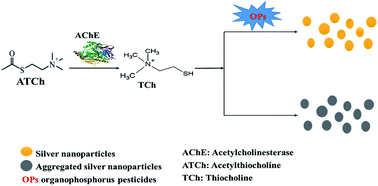Developing acetylcholinesterase-based inhibition assay by modulated synthesis of silver nanoparticles: applications for sensing of organophosphorus pesticides†
Abstract
A novel and highly sensitive sensing strategy for the detection of organophosphorus compounds (OPs) based on the catalytic reaction of acetylcholinesterase (AChE) and acetylcholine (ATCh) during the modulated synthesis of silver nanoparticles (AgNPs) has been developed. The enzymatic hydrolysis of ATCh by AChE yields thiocholine (TCh), which induces the aggregation of AgNPs during synthesis, and the absorption peak at 382 nm corresponding to AgNPs decreases. The enzymatic reaction can be regulated by OPs, which can covalently bind to the active site of AChE and decrease the TCh formation, thereby decreasing the aggregation and significantly enhancing the absorption peak at 382 nm. The proposed system achieved good linearity and limits of detection of 0.078 nM and 2.402 nM for trichlorfon and malathion, respectively, by UV-visible spectroscopy. Further, the sensitivity of the proposed system was demonstrated through the determination of OPs in different spiked real samples. The described work shows the potential application for further development of a colorimetric sensor for other OP pesticide detection during the synthesis of AgNPs using enzyme-based assays.


 Please wait while we load your content...
Please wait while we load your content...